Global Affairs
Bharat’s Global Footprint
Posted On:
18 JUN 2025 9:13AM
Introduction
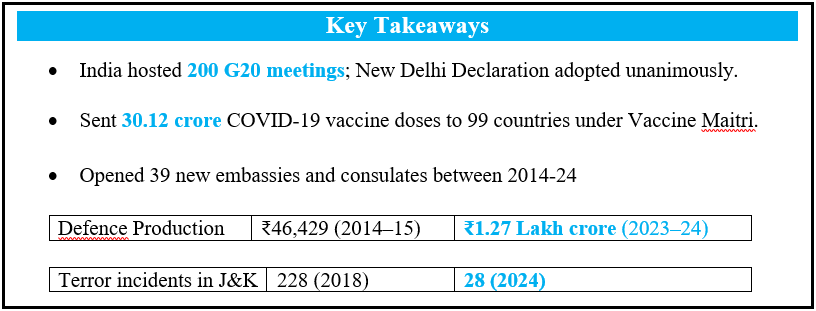
India has emerged as a formidable global leader over the past 11 years, driven by bold initiatives that fuse ambition with action. From championing climate solutions to spearheading AI governance, India has shaped international discourse while keeping its national interests first. Prime Minister Narendra Modi’s leadership has anchored these efforts in responsibility and inclusivity, ensuring India’s voice resonates across global platforms.
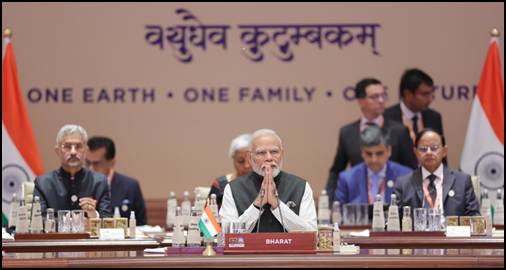
India’s presidency of the G20 spotlighted the Global South and delivered concrete outcomes, including the launch of the Global Biofuels Alliance. Whether through diplomacy, humanitarian aid, or strategic defence, India has crafted a new narrative of influence and self-reliance.
Global Leadership Through Initiatives

In the last 11 years, India has stepped up as a global leader through impactful initiatives that blend vision with execution. Whether it is climate change, energy transition, public health or artificial intelligence, India has driven conversations and crafted coalitions that put the nation’s priorities at the centre of global discourse. Under Prime Minister Modi’s leadership, India’s approach has been rooted in responsibility and inclusion, always placing national interest within a wider humanitarian framework. These initiatives have helped India shape a new global order while safeguarding its sovereignty and amplifying its strategic voice.
G20 Presidency: Championing 'One Earth, One Family, One Future'
India’s presidency of the G20 from December 1, 2022, to November 30, 2023, marked a defining chapter in global diplomacy. The 18th G20 Leaders’ Summit held at Bharat Mandapam in New Delhi on 9–10 September 2023 brought together 20 member states, nine invitee countries, and 14 international organisations. India hosted over 200 meetings in 60 cities, with more than one lakh delegates. The presidency’s theme “Vasudhaiva Kutumbakam", reflected India’s civilisational ethos and desire for global cooperation.


A major highlight was the unanimous adoption of the New Delhi Leaders’ Declaration, despite deep divides on global issues like the Ukraine conflict. This achievement underscored India’s growing stature as a consensus-builder and its ability to lead amid global uncertainty.
AI Action Summit in Paris: Shaping Global AI Standards
On 10 February 2024, Prime Minister Modi co-chaired the AI Action Summit in Paris with French President Emmanuel Macron. The summit featured high-level discussions on responsible and inclusive AI development. It concluded a week-long series of events including Science Days and a Cultural Weekend.
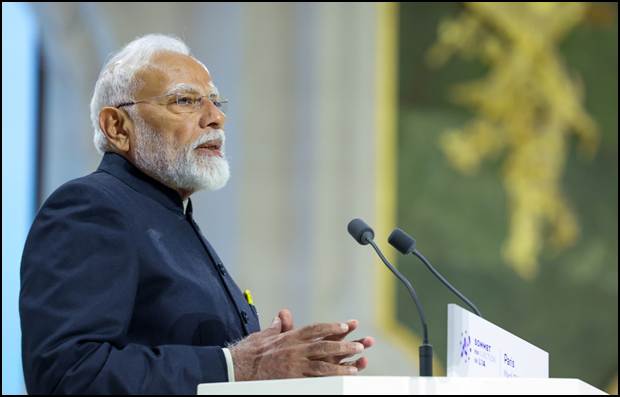
The High-Level Segment at Élysée Palace brought together world leaders, international organisations, and top industry figures. India's co-leadership in this summit reflected its growing influence in emerging technologies and its insistence on aligning tech progress with democratic values.
Vaccine Maitri: Humanity First, Always
During the COVID-19 crisis, India launched the Vaccine Maitri initiative as a testament to its human-centric diplomacy. Since January 2021, India supplied over 30.12 crore vaccine doses to 99 countries and two UN bodies.
This included 1.51 crore doses gifted to over 50 nations and 5.2 crore doses through the COVAX mechanism. India’s swift and large-scale assistance bolstered its image as a reliable partner for global health and a compassionate voice from the Global South.
International Solar Alliance: Powering a Cleaner Planet

Launched at COP21 in Paris on 30 November 2015 by Prime Minister Modi and French President François Hollande, the International Solar Alliance is India’s flagship climate action effort. With 120 member and signatory countries, the ISA aims to mobilise over USD 1,000 billion in solar investments by 2030. Headquartered in Gurugram, it is the first international intergovernmental body based in India. At the 7th Session held in New Delhi from 3–6 November 2024, the ISA pushed for rapid deployment of solar energy in underserved regions. It focused on innovations, funding mechanisms, and cross-border cooperation, placing India at the forefront of global solar transition.
India as First Responder: A Pillar in Times of Crisis
In the past five years, India has provided humanitarian assistance and disaster relief to over 150 countries. It has deployed medical teams, relief supplies, and expert manpower to address crises ranging from pandemics to natural disasters. In July 2021, the Ministry of External Affairs set up the Rapid Response Cell to coordinate with national agencies and foreign governments. India has also extended its support through plurilateral groups like the Quad. These efforts reflect not only India’s capabilities but also its sense of duty as a responsible power.
Strengthening Regional and Global Partnerships

India’s foreign policy in the past 11 years has reflected a careful balance of principle, pragmatism and national interest. Under the leadership of Prime Minister Narendra Modi, the Government has placed India firmly on the global stage, building lasting partnerships and safeguarding strategic autonomy. Whether in the immediate neighbourhood or the wider Indo-Pacific, whether in multilateral forums or in engagements with the Global South, India has spoken with clarity and purpose. Every initiative, alliance and summit has placed the Indian people’s interests first while contributing meaningfully to global peace and development.
Neighbourhood First Policy
India's 'Neighbourhood First' policy has shaped a bold, forward-looking approach to regional ties. The policy prioritises stronger physical, digital and cultural links with neighbours such as Bhutan, Nepal, Sri Lanka, Maldives, Myanmar, Bangladesh and Afghanistan. It is guided by the principles of respect, dialogue, peace and prosperity. India's support has ranged from high-level infrastructure to local development projects.
Hydropower and connectivity projects in Bhutan, development partnership projects in Sri Lanka, Nepal, Myanmar and Bangladesh, and humanitarian assistance to Afghanistan are geared towards enhancing bilateral ties and strengthening people-to-people relations. India has also built hospitals and schools in Nepal under High Impact Community Development Projects. In Sri Lanka and Maldives, defence cooperation and maritime partnerships have deepened. For Myanmar, India has extended both aid and infrastructure support. The policy remains consultative, non-reciprocal and outcome-focused.
The Act East Policy, upgraded in 2014 from the earlier Look East Policy, has expanded India’s outreach to Southeast Asia and the Indo-Pacific. With ASEAN at its core, the policy champions economic partnerships, cultural exchanges and security ties.
India has built stronger bilateral relations while taking active part in key regional forums like the East Asia Summit, QUAD and ASEAN Defence Ministers Meeting Plus. The focus remains on comprehensive connectivity—physical, digital and people-centric. Through this policy, India has added momentum to its Indo-Pacific vision while anchoring its strategic position in the region.
Engagement with the Global South
India’s leadership in the Global South is rooted in shared history and common aspirations. Through development partnerships, financial aid and capacity building, India has supported fellow developing nations in tangible ways. The three editions of the Voice of Global South Summit, held in January and November 2023 and August 2024, reflected India’s commitment to amplifying southern voices. Participation from over 100 countries at each edition spoke volumes about India’s credibility.
In March 2025, Prime Minister Modi launched the MAHASAGAR doctrine in Mauritius, reinforcing India’s goal of Mutual and Holistic Advancement for Security and Growth Across Regions. Projects across sectors like education, health and housing are being executed in Global South countries, along with scholarships and skill development support.
India’s global diplomacy has taken shape through strategic partnerships in multilateral and plurilateral platforms. In BRICS, India has worked to make the global order more representative and multipolar. Through QUAD, India is shaping security and economic frameworks in the Indo-Pacific. At the G20 Summit, India helped conclude the India-Middle East-Europe Economic Corridor Agreement and led the formation of the Global Biofuels Alliance.
These milestones reflect not only India's leadership but its ability to build consensus on complex global issues. In every engagement, the country has put sovereignty, security and the interest of its citizens at the heart of its diplomacy.
New Embassies and Consulates
Between 2014 and 2024, India opened 39 new embassies and consulates across the world. The total number now stands at 219. This expansion has sharpened India’s global presence and outreach. Each mission reflects the government’s clear focus on national interest.
It also shows the importance given to diplomacy as a tool of development and security. The growing footprint has helped boost trade, deepen ties and support Indian citizens abroad. This is diplomacy with purpose, firm and forward looking, always putting the nation first.
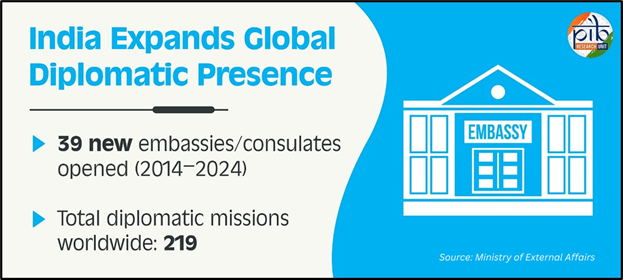
Advancing Strategic Global Ties
India's foreign engagements have entered a new phase of dynamism and purpose, driven by its commitment to strategic autonomy and multilateral cooperation. In recent years, relations with major global powers such as the United States, Russia, France, and Saudi Arabia have grown deeper, more structured, and increasingly future-oriented. From defence and trade to technology and people-to-people ties, these partnerships reflect India’s evolving role as a key player on the global stage.
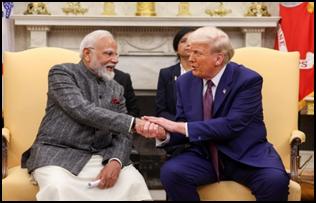
India-U.S. bilateral relations have developed into a "global strategic partnership", based on shared democratic values and increasing convergence of interests on bilateral, regional and global issues. India’s relations with the United States have grown into a high-trust and future-focused partnership over the past eleven years. Prime Minister Narendra Modi’s Official Working Visit to Washington on 13 February 2025, hosted by President Donald J. Trump, opened a new chapter in this engagement. The launch of the U.S.-India COMPACT (Catalyzing Opportunities for Military Partnership, Accelerated Commerce &Technology) signalled a strong push towards deeper cooperation in defence, trade and technology. Under “Mission 500,” both sides aim to double bilateral trade to 500 billion dollars by 2030 and plan to finalise a comprehensive trade agreement by autumn 2025. Defence ties were further strengthened with the announcement of a new ten-year Framework for the Major Defense Partnership. India’s armed forces continue to benefit from the inclusion of cutting-edge U.S. platforms such as the C-130J, C-17, P-8I, Apache, and MQ-9B.
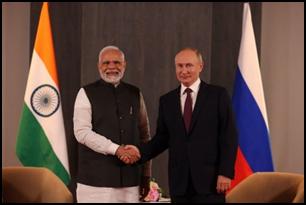
India’s ties with Russia have grown deeper and more structured over the past eleven years. As a trusted strategic partner, Russia has remained central to India’s foreign policy. Regular engagements take place through institutional mechanisms like the Intergovernmental Commission, which handles cooperation in trade, technology, defence, and culture. A key milestone was the first 2+2 Dialogue held in December 2021, bringing together Foreign and Defence Ministers alongside summit-level talks between Prime Minister Modi and President Putin. Defence cooperation has expanded from simple purchases to joint production and research, covering platforms like the S-400 system, T-90 tanks, Su-30 MKI jets, and BrahMos missiles.
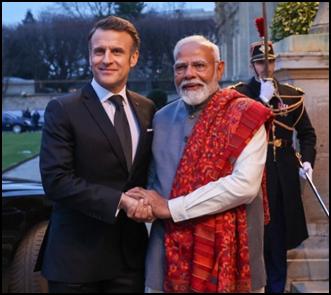
India and France share a long-standing and trusted partnership built on shared democratic values, respect for international law, and belief in multilateralism. The ties span security, economy, climate, and people-to-people links. Recently, Prime Minister Narendra Modi visited France from 10 to 12 February 2025 at President Emmanuel Macron’s invitation. Together, they co-chaired the AI Action Summit, which saw the participation of 30 Heads of State or Government, 57 Ministers, 12 international organisations, and 41 business leaders. The summit adopted the statement “Inclusive and Sustainable Artificial Intelligence for People and the Planet” and launched the Public Interest AI Platform and Incubator. India will host the next summit. Bilateral talks in Paris and Marseille advanced cooperation under the Horizon 2047 Roadmap, built around security, the planet, and people. Defence remains a key pillar, with the induction of 36 Rafale jets into the Indian Air Force standing as a symbol of deep trust and collaboration. Earlier, in July 2023, Prime Minister Modi had visited France as Guest of Honour at the French National Day.
India-UK Comprehensive Strategic Partnership has strengthened across all sectors. The recent conclusion of India-UK FTA and Double Contribution Convention is a milestone in our bilateral ties which will unlock huge potential of bilateral cooperation in key sectors. Significant initiatives have been taken in technology, defence and security, health and infrastructure financing sectors including Technology and Security Initiative, and
UK-India Infrastructure Financing Bridge. University of Southampton is opening its campus in India soon, and more UK Universities are planning to open their campuses in India. This along with recent opening of our two new consulates in Manchester and Belfast have further strengthened our educational and people to people ties.
India and the EU, the two largest democracies, open market economies and pluralistic societies share a strategic partnership since 2004. EU was India’s largest trading partner in goods in FY 23-24 with bilateral trade of US $137 billion, while trade in services (2023) stood at around US$ 53 billion. Beyond the regular India-EU summits, the two sides have also established a Trade and Technology Council (TTC) - a dedicated platform to anchor discussions on issues of strategic importance at the intersection of trade, trusted technology, and security. Notably, this is the first such mechanism for India with any partner and the second for the EU after its TTC with the United States. The first-ever visit of the EU College of Commissioners to India in February 2025 was a milestone event in bilateral ties, which encompassed discussions across sectors with over 20 ministerial level meetings in addition to the interaction at the leaders’ level.
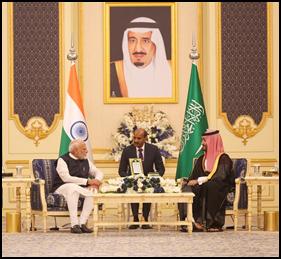
India’s ties with the Middle East have grown significantly, driven by strategic, economic, and cultural engagement. With Saudi Arabia, relations date back to 1947 and were further strengthened during the Strategic Partnership Council meeting in Jeddah on 22 April 2025, co-chaired by Prime Minister Narendra Modi and Crown Prince Mohammed bin Salman. Key developments included new Ministerial Committees on Defence and Cultural Cooperation and progress by the High-Level Task Force on Investment, including plans for two refineries. The over 2.65 million-strong Indian community in Saudi Arabia continues to be a vital link between the two nations.
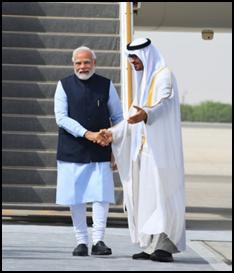
India-UAE relations, established in 1972, have deepened across trade and strategic platforms like BRICS and I2U2. The Comprehensive Economic Partnership Agreement (CEPA), in effect since May 2022, has boosted bilateral trade from USD 43.3 billion in FY 2020–21 to USD 83.7 billion in 2023–24. Non-oil trade reached USD 57.8 billion, supporting the target of USD 100 billion by 2030. Exports worth USD 19.87 billion were enabled through nearly 2.4 lakh Certificates of Origin issued under CEPA.
India-Qatar ties have grown with regular high-level engagement and strong defence cooperation. During the State Visit of HH Sheikh Tamim bin Hamad Al-Thani in February 2025, Qatar announced a USD 10 billion investment in sectors like infrastructure, food security, and technology. Both sides agreed to explore a Comprehensive Economic Partnership Agreement and to double bilateral trade by 2030. They also welcomed the launch of India’s Unified Payment Interface (UPI) at QNB’s Points of Sale in Qatar, with plans for a nationwide rollout.
Support Beyond Borders
Over the past 11 years, India’s foreign policy has been firmly centred on protecting its citizens abroad. The Government has acted quickly and with resolve whenever Indians faced danger, whether from conflicts, crises, or natural disasters. Millions of Indians have been brought home safely through timely and well-coordinated efforts. This approach reflects a strong commitment to putting the nation and its people first.
Relief and Evacuation Operations
India’s approach to foreign policy over the past 11 years has not only been marked by diplomacy and dialogue, but also by decisive action when the safety of its citizens abroad was at stake. In times of conflict, crisis or calamity, the Government has acted with speed, compassion and precision. Relief and evacuation efforts have become defining examples of the "nation first" policy. Whether it was a pandemic, political upheaval or natural disaster, India brought its people home safely and swiftly.
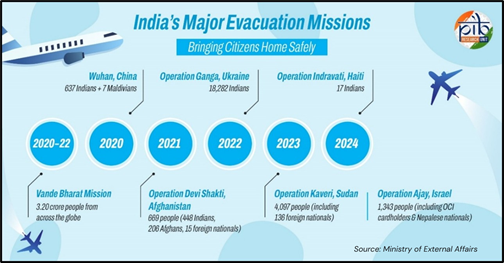
Here are some of the major evacuation missions:
Vande Bharat Mission
Launched during the COVID-19 pandemic, this mission remains one of the largest repatriation efforts globally. Between May 2020 and March 2022, 3.20crore people(disembarkation-1.60 crore & embarkation 1.60 crore) were facilitated. Both commercial and chartered flights, including those under air bubble arrangements, ensured that stranded Indians and foreign nationals could return to their homes.
Evacuation from China (2020)
At the onset of the Covid-19 pandemic in early 2020, India acted swiftly to evacuate 637 Indian citizens and 7 Maldivians from Wuhan, China. The early response helped prevent potential risks and demonstrated prompt crisis management.
Operation Devi Shakti
As the situation in Afghanistan deteriorated in 2021, India undertook a humanitarian mission to evacuate 669 individuals. Among them were 448 Indians and 206 Afghans, including members of the Afghan Hindu and Sikh communities. Fifteen foreign nationals were also rescued using six IAF and Air India flights. Additionally, the Government ensured the return of five holy saroops of Sri Guru Granth Sahib, which were brought back with great reverence on a separate flight.
Operation Ganga
In February and March 2022, the Government responded to the Ukraine conflict with a large-scale evacuation of Indian students. A total of 18,282citizens were rescued by 90 flights, of which 76 were commercial flights and 14 IAF flights. The entire operation was funded by the Government of India, ensuring students and families faced no financial burden.
Operation Kaveri
When conflict erupted in Sudan in 2023, India swiftly launched Operation Kaveri. A total of 4,097 people, including 136 foreign nationals, were brought back using 18 IAF sorties, 20 commercial flights and 5 Indian Navy ship movements. The operation also managed to evacuate 108 Indian nationals through land routes from neighbouring countries like Chad, Egypt, Ethiopia and South Sudan.
Operation Ajay
Amid hostilities in Israel in 2023, India stepped in once again. Under Operation Ajay, 1,343 individuals were brought back on six special flights. This included 1,309 Indian citizens, 14 Overseas Citizen of India (OCI) card holders and 20 Nepalese nationals.
Operation Indravati
In March 2024, civil unrest gripped Haiti. India swiftly launched Operation Indravati to ensure the safety of its citizens. Seventeen Indian nationals were safely airlifted to the Dominican Republic using helicopters, marking another success in India’s people-centric foreign policy.
Indian Community Welfare Fund (ICWF)
Set up in 2009, the Indian Community Welfare Fund has become a lifeline for Indians abroad. Since 2014, 3,42,992 people have been assisted through this fund. It helps those in need during emergencies, whether stranded, injured, or facing legal or financial trouble.
The fund has also supported large-scale evacuations from conflict zones and disaster-hit regions. In 2017, its guidelines were revised to broaden its scope and give Indian Missions greater flexibility to respond quickly. Over the past 11 years, the ICWF has stood as a strong symbol of a foreign policy that puts citizens first.
Mobility and Migration Partnership Arrangements
Between 2014 and 2025, India signed mobility and migration partnership arrangements with 18 countries, including Saudi Arabia, France, the UAE, Japan, the UK, Australia, and Germany. These agreements have opened up overseas employment opportunities for countless Indian nationals, ensuring safer, structured, and mutually beneficial pathways for work and skilled migration.
Counter-Terrorism and Internal Security

India’s firm and clear-eyed approach to internal security and counter-terrorism over the last eleven years reflects the government’s unwavering resolve to prioritise national interest above all. From precision military strikes across borders to strategic dismantling of insurgent networks within, India has shed the hesitations of the past. A clear doctrine now guides action, swift, decisive and backed by intelligence. With the abrogation of Article 370, the campaign against Naxalism, and new capabilities in high-tech defence, India today stands more secure and self-reliant than ever before. Operation SINDOOR, India’s swift and precise military response to a terror attack in April 2025, further demonstrated this resolve. These successes are a result of political will, military strength and a deeply rooted belief in putting the country first.
Surgical Strikes and Balakot Air Strikes
In a bold departure from past restraint, India responded to the terrorist attack in Uri on 18 soldiers by conducting Surgical Strikes on 28-29 September 2016. These strikes inflicted heavy losses on terrorists and their protectors across the Line of Control. A few years later, on 14 February 2019, the Pulwama terror attack claimed 40 CRPF jawans. India’s response came swiftly. On 26 February 2019, in an intelligence-led operation, the Balakot airstrikes eliminated a large number of Jaish-e-Mohammad terrorists, including senior commanders. The facility targeted was located far from civilian areas and headed by Maulana Yousuf Azhar, brother-in-law of JeM chief Masood Azhar. These pre-emptive actions showed the world that India would no longer tolerate proxy war through terrorism.

In April 2025, following a brutal terror attack on civilians in Pahalgam, India launched Operation SINDOOR, executing precise retaliatory strikes against nine terrorist camps in Pakistan and Pakistan-occupied Jammu and Kashmir. The Indian military, acting on accurate intelligence, relied on drone strikes, loitering munitions, and layered air defence to neutralise key threats without crossing international boundaries. When Pakistan launched drone and missile attacks on 7–8 May against multiple Indian cities and bases, these were swiftly intercepted, showcasing the effectiveness of India’s net-centric warfare systems and integrated counter-UAS (unmanned aerial systems) grid.
In his address to the nation, Prime Minister Narendra Modi reiterated India’s firm policy on cross-border terrorism and its approach towards Pakistan. He underlined that national security is non-negotiable and outlined clear red lines regarding dialogue, deterrence, and defence. Key points from his address include:
- Firm response to terror attacks: Any terrorist attack on India will be met with a fitting and decisive response, regardless of where the perpetrators operate from.
- No tolerance for nuclear blackmail: India will not be deterred by nuclear threats and will continue to carry out precise strikes against terrorist hideouts.
- No distinction between terror elements: There will be no difference between the masterminds and the sponsors of terror, both will be held accountable.
- Terrorism first in any talks: Any engagement with Pakistan, if at all, will be focused only on terrorism or the issue of Pakistan-occupied Kashmir.
- Zero compromise on sovereignty: The Prime Minister declared, “Terror and talks cannot go together, terror and trade cannot go together, and water and blood cannot flow together,” firmly closing the door to normal relations amid terror threats.
Abrogation of Article 370 and Reorganisation of Jammu & Kashmir
On 5 August 2019, Parliament approved the removal of Article 370 and 35-A, marking a historic correction of a decades-old imbalance. Jammu & Kashmir and Ladakh were brought at par with other regions, and over 890 Central laws were applied. As many as 205 state laws were repealed, and 130 modified to align with the Constitution of India.
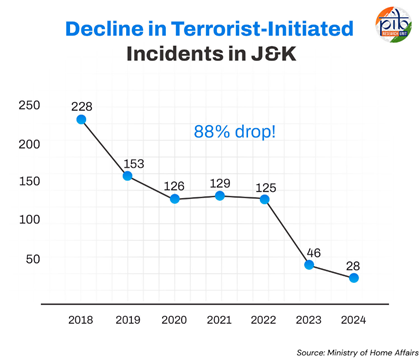
Since then, development in the region has accelerated. Marginalised groups like Valmikis, Dalits, and Gorkhas now enjoy full rights. Laws such as the Right to Education and Child Marriage Act now protect all citizens in the region. The impact is clear: terrorist-initiated incidents have dropped from 228 in 2018 to just 28 in 2024, demonstrating a strong correlation between integration and peace.
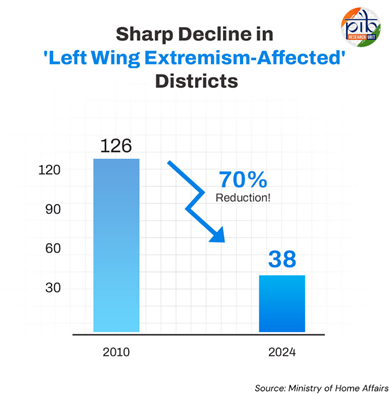
The multi-pronged approach to Left Wing Extremism has delivered historic gains. From 126 affected districts in 2010, the number has come down to just 38 by April 2024. Most affected districts were reduced from 12 to 6, and the number of casualties is at a 30-year low. Violence has declined sharply from 1,936 incidents in 2010 to 374 in 2024, a drop of 81 percent. Deaths have reduced by 85 percent over the same period.
In 2024 alone, 290 Naxals were neutralised, 1,090 arrested, and 881 surrendered. Major recent operations in March 2025 saw 50 Naxals surrender in Bijapur, 16 neutralised in Sukma, and 22 killed in Kanker and Bijapur. With continued support through Special Central Assistance and targeted development, the government is on track to eliminate Naxalism by 31 March 2026.
Forging Defence Strength

Over the past eleven years, India has redefined its defence capabilities with a firm emphasis on self-reliance and global stature. The shift from dependency on foreign suppliers to becoming a major player in indigenous defence manufacturing is one of the most significant achievements of the current government. Backed by strong political will and strategic policy reforms, the country has not only secured its borders but also expanded its defence footprint across the world. This growth has been driven by Make in India, record-breaking exports, massive procurement deals, and infrastructure development through industrial corridors. India is now exporting to over 100 countries, producing world-class systems at home, and modernising its Armed Forces at a rapid pace.
Surge in Indigenous Defence Production
India achieved its highest-ever defence production in FY 2023–24, with the total value touching ₹1,27,434 crore. This marks a 174 percent rise from ₹46,429 crore in 2014–15.
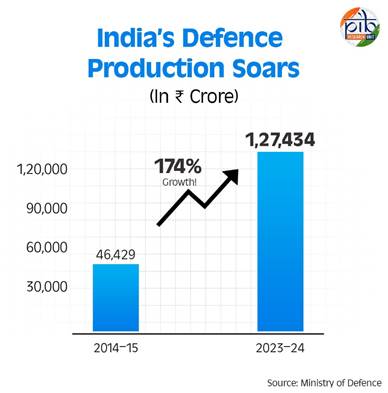
Indigenous platforms such as the Light Combat Aircraft Tejas, Arjun tank, Akash missile system, ALH Dhruv helicopter, and several naval vessels have all contributed to this success. The growth has been powered by focused policies and a strong push for Atmanirbharta, or self-reliance.
Unprecedented Rise in Defence Exports
In FY 2024–25, India recorded defence exports worth ₹23,622 crore, up from ₹686 crore in FY 2013–14. The private sector contributed ₹15,233 crore while DPSUs accounted for ₹8,389 crore, a 42.85 percent jump from the previous year.
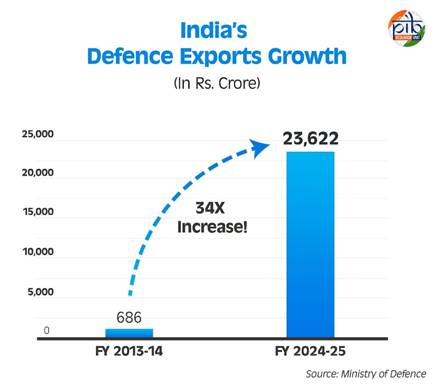
Over 1,700 export authorisations were granted in the same year. India now exports a diverse range of products such as bulletproof jackets, helicopters, torpedoes, and patrol boats. The USA, France, and Armenia were the top buyers in 2023–24. With the goal of reaching ₹50,000 crore in exports by 2029, India is firmly positioning itself as a global hub for defence manufacturing.
Positive Indigenisation Lists
The government has issued five Positive Indigenisation Lists that limit imports and encourage local manufacturing. Over 5,500 items are covered under these lists, of which 3,000 had been indigenised by February 2025. The lists include everything from basic components to advanced systems like radars, rockets, artillery, and light helicopters. This structured push has ensured that critical capabilities are now being built within the country.
Defence Industrial Corridors
Two dedicated Defence Industrial Corridors have been established in Uttar Pradesh and Tamil Nadu. These corridors have attracted investments worth over ₹8,658 crore and signed 253 MoUs with an estimated investment potential of ₹53,439 crore as of February 2025. Spread across 11 nodes in both states, these hubs are providing the infrastructure and incentives needed to turn India into a defence manufacturing powerhouse.
Record Defence Contracts in 2024–25
The Ministry of Defence signed 193 contracts worth ₹2,09,050 crore in 2024–25 — the highest ever in a single year. Of these, 177 contracts were awarded to the domestic industry, amounting to ₹1,68,922 crore.
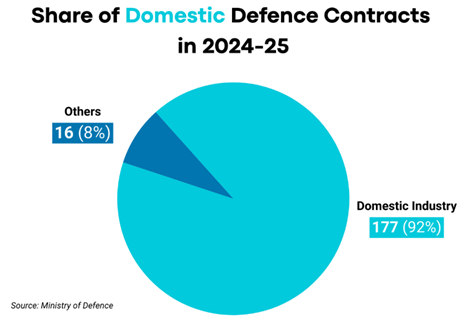
This shows a clear shift towards prioritising Indian manufacturers and strengthening the defence ecosystem within the country. The focus on indigenous procurement has also boosted job creation and technological advancement.
Innovations for Defence Excellence (iDEX)
Launched in April 2018, Innovations for Defence Excellence (iDEX) has fostered a vibrant ecosystem for innovation and technology development in the defence and aerospace sectors. By engaging MSMEs, startups, individual innovators, R&D institutes, and academia, iDEX has provided grants of up to ₹1.5 crore to support the development of cutting-edge technologies. Strengthening its impact, the Armed Forces have procured 43 items worth over ₹2,400 crore from iDEX-supported startups and MSMEs, reflecting growing trust in indigenous innovation for defence preparedness.

To further enhance self-reliance in defence technology, ₹449.62 crore has been allocated to iDEX, including its sub-scheme Acing Development of Innovative Technologies with iDEX (ADITI), for 2025-26. As of February 2025, 549 problem statements have been opened, involving 619 startups and MSMEs, with 430 iDEX contracts signed.
India’s maritime strategy centres on vigilance, quick response and active regional engagement. With a long coastline and key shipping routes to protect, the Indian Navy plays a vital role in safeguarding national and economic interests. Guided by the Prime Minister’s vision of MAHASAGAR, India promotes cooperation and stability across oceans. Over the past year, in response to piracy and rising threats in the Western Arabian Sea, the Navy deployed over 35 ships, conducted more than 1,000 boarding operations and responded to 30-plus incidents. These efforts saved over 520 lives and ensured safe passage for 312 merchant vessels carrying cargo worth more than 5.3 billion US dollars.
India’s commitment extends beyond defence. It remains a reliable first responder in the Indian Ocean Region for humanitarian and disaster relief missions. In September 2024, India launched Operation Sadbhav to support Laos, Vietnam and Myanmar after Typhoon Yagi. In April 2025, it hosted the ‘Africa India Key Maritime Engagement’ (AIKEYME) exercise with ten African nations, strengthening maritime ties and shared responses to regional challenges. India’s maritime outlook balances strong naval presence with inclusive diplomacy, shaping a secure and cooperative Indo-Pacific.
Conclusion
India’s journey over the past 11 years showcases its transformation into a confident global power. Through strategic initiatives, from the G20 presidency to the International Solar Alliance, India has led with purpose and pragmatism. Its commitment to humanitarian aid, regional partnerships, and counter-terrorism reflects a nation that places its people first while contributing to global stability. With a focus on self-reliance, from defence production to technological innovation, India has strengthened its sovereignty and global standing. This era of bold leadership and inclusive diplomacy positions India as a pivotal force in shaping a balanced, prosperous world order.
References:
Ministry of External Affairs
Ministry of Defence
Ministry of Information & Broadcasting
Prime Minister’s Office
Ministry of New and Renewable Energy
Ministry of Home Affairs
Ministry of Commerce & Industry
PIB Backgrounders
Bharat’s Global Footprint
****
Explainer 17/ Series on 11 Years of Government
Santosh Kumar/ Sarla Meena/ Saurabh Kalia
(Backgrounder ID: 154680)
आगंतुक पटल : 10873
Provide suggestions / comments
इस विज्ञप्ति को इन भाषाओं में पढ़ें:
हिन्दी